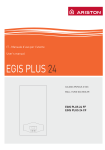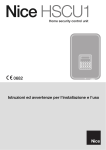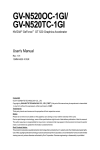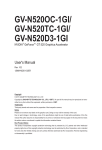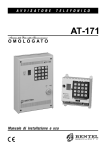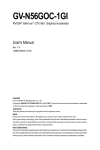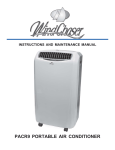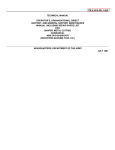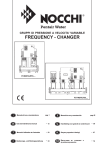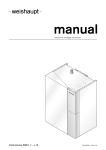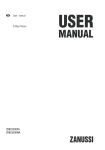Download Multilanguage - Pentair Nocchi
Transcript
EASYBOOST GRUPPI DI PRESSIONE CON 2 POMPE BOOSTER SETS WITH 2 PUMPS 253PB090-10-1407 IT Originale Istruzioni per l‘uso EN Instruction Manual www.pentair.com 2 ITALIANO INDICAZIONI DI SICUREZZA INSTALLAZIONE Prestare particolare attenzione alle diciture contrassegnate con la seguente simbologia. Schema di installazione normalmente utilizzato. Pericolo generico per le persone Pericolo tensione elettrica ATTENZIONE! Pericolo per macchinari e funzionamento Il presente apparecchio può essere utilizzato da bambini a partire da 8 anni e da persone con disabilità fisiche, sensoriali o mentali o carenza di esperienza e conoscenze, se sottoposti alla supervisione o sono state istruite sull'uso dell'apparecchio e ne hanno compreso i pericoli risultanti. Ai bambini non è consentito giocare con l'apparecchio. La pulizia e la manutenzione dell'utente non può essere eseguita da bambini senza supervisione. Prima di procedere all'installazione, leggere attentamente il contenuto del presente manuale. I danni provocati dal mancato rispetto delle indicazioni riportate non potranno essere coperti dalla garanzia. GENERALITA’ I nostri gruppi di pressurizzazione sono costruiti per il pompaggio di acqua pulita. Devono essere installati in locali protetti dalle intemperie e dal gelo, ben aerati e in atmosfera non pericolosa. Ogni nostro gruppo è collaudato in tutte le sue parti nei nostri stabilimenti. Al momento della consegna verificare che il gruppo non abbia subito danni durante il trasporto; in tal caso avvertire immediatamente il rivenditore. In ogni caso entro e non oltre dieci giorni dalla data di acquisto. LIMITI D'IMPIEGO ATTENZIONE: prima di procedere al controllo dell’adescamento delle pompe, verificare che la loro pressione massima, riportata sulla targa delle pompe stesse, sia compatibile con la pressione sopportata dall’impianto e dalle sue apparecchiature e che eventuali valvole di sicurezza abbiano un valore di intervento superiore a quello della pressione massima delle pompe. ATTENZIONE! Il gruppo non è adatto al pompaggio di liquidi chimicamente aggressivi o infiammabili. ATTENZIONE! Evitare tassativamente il funzionamento a secco delle elettropompe. Temperatura Massima temperatura del liquido pompato: 40°C Massima temperatura ambiente: 40°C, (50°C per le elettropompe DHR, VLR) Fig. 1 Tutte le operazioni relative alla installazione devono essere effettuate con gruppo scollegato dalla rete di alimentazione. Nel caso che il gruppo dì pressurizzazione venga alimentato da pozzo, per evitare che si verifichino fenomeni di disadescamento, si consiglia di controllare i dati caratteristici dello stesso: - Livello statico ( livello iniziale dei pozzo ) - Livello dinamico ( livello raggiunto durante il funzionamento dei gruppo) - Portata - Hmax aspirazione Per ridurre le perdite di carico è necessario installare il gruppo il più vicino possibile al punto di prelievo e predisporre una tubazione d'aspirazione con il minor numero possibile di curve che dovranno essere in ogni caso ad ampio raggio. Anche il diametro della tubazione dovrà essere calcolato in modo da ridurre al minimo le perdite di carico per cui è necessaria una dimensione maggiore o uguale a quella delle bocche di aspirazione delle pompe. Per evitare la formazione di sacche d'aria nelle tubazioni d'aspirazione è necessario che queste abbiano sempre una pendenza positiva, dal basso verso l'alto, evitando contropendenze o "colli d'oca”, e che nei collegamenti non vi siano infiltrazioni d'aria. Collegare il collettore di mandata del gruppo al collettore di distribuzione interponendo un giunto antivibrante. Questo collegamento può essere effettuato sia dal lato destro o sinistro del collettore spostando la calotta filettata. ATTENZIONE! E' buona norma prevedere lo smaltimento di perdite di acqua provenienti dalla eventuale cattiva tenuta di guarnizioni, tenute meccaniche, tracimazione di serbatoi, ecc. 3 ITALIANO Nel caso che nelle immediate vicinanze dei gruppo, sulla tubazione di mandata, non ci siano punti di prelievo consigliamo l'installazione di un rubinetto di prova. COLLEGAMENTI ELETTRICI L’alimentazione del quadro deve prevedere un dispositivo differenziale con corrente di intervento non superiore a 30 mA. E’ necessario controllare periodicamente la pressione di precarica dei vasi a membrana che deve risultare 0,2 ÷ 0,3 BAR inferiore alla pressione minima di chiusura del pressostato tarato più basso. Detto controllo deve essere effettuato in assenza di pressione nell’impianto o a serbatoi smontati. ADESCAMENTO DEL GRUPPO Riferirsi alla Fig.1 Operare sempre con l’alimentazione elettrica disinserita. ATTENZIONE! Prima di mettere in funzione il gruppo è necessario provvedere al suo riempimento. Nel caso di aspirazione con battente positivo, deposito fuori terra, acquedotto o condotta in pressione, provvedere all'adescamento del gruppo come segue: ∙∙ aprire tutte le valvole e togliere i tappi di carico sia sul collettore di aspirazione che sulle pompe; ∙∙ aprire la valvola di intercettazione dell’alimentazione idrica sino alla fuoriuscita dell'acqua; ∙∙ richiudere il rubinetto di alimentazione ed i tappi di carico. Nel caso che l'alimentazione del gruppo sia con battente negativo, pozzo o serbatoio interrato, provvedere all'ade-scamento del gruppo come segue: ∙∙ aprire tutte le valvole e togliere i tappi di carico sulle pompe e sul collettore d'aspirazione; ∙∙ effettuare il riempimento d'acqua attraverso la tubazione d'aspirazione; ∙∙ effettuare i rabbocchi necessari attraverso i tappi di carico sui corpi pompa fino al riempimento completo; ∙∙ rimontare i tappi. Accertarsi che l’alimentazione elettrica sia provvista di un efficiente impianto di terra secondo le vigenti normative. ATTENZIONE! Nel quadro monofase standard, non è previsto un interruttore generale. ATTENZIONE! Accertarsi che la tensione e la frequenza di targa corrispondano a quelle di alimentazione disponibile. ATTENZIONE! L'impianto di alimentazione elettrica deve essere dotato di un interruttore magnetotermico differenziale con sensibilità richiesta dalla normativa per il tipo di installazione. ATTENZIONE! Prima di collegare il cavo d'alimentazione al quadro di comando, assicurarsi che il suo dimensionato sia sufficiente per sopportare la corrente massima richiesta dalle pompe del gruppo. ATTENZIONE! Il collegamento dei quadri elettrici alla rete di alimentazione deve essere effettuato seguendo le indicazioni riportate sullo schema dei collegamenti elettrici contenuti nel quadro di comando. I nostri gruppi vengono consegnati con i morsetti "LIV" ponticellati (L1-L2 per il quadro Monofase, Fig.2; 5-6 per il quadro Trifase, Fig.3). ATTENTIONE! In questo caso il gruppo non è protetto contro il funzionamento a secco. E’ quindi necessario rimuovere i ponti elettrici e collegarvi il dispositivo di controllo prescelto. Tramite interruttore a galleggiante Il galleggiante deve essere installato nella vasca collegato con due conduttori agli appositi morsetti del quadro di comando. Tramite un pressostato di minima inverso Nel caso in cui il gruppo venga alimentato da una condotta idrica in pressione ( ad esempio acquedotto comunale ) è necessario installare un pressostato di minima pressione che interdica il funzionamento del gruppo se la pressione nella condotta scende al di sotto del valore prestabilito. Pressostato 1 Pressostato 2 Protezione Marcia a secco Tagliare I ponticelli per il collegamento agli altri apparecchi di controllo Fig. 2 4 Fig. 3 ITALIANO Quadro Elettrico Monofase Pompa 2, 1x230V Pompa 1, 1x230V Contatti BMS (Building Management System) Morsettiera Dispositivi Esterni Scheda EB1 LED di sistema BMS LEDs Porta fusibili Trim di regolazione Temporizzazione 0-180’’ Connettori Alimentazione 230V & Contatto di Terra Connettori di uscita Pompa 1 (M1) & Pompa 2 (M2) Fig. 4 AUT Spia Verde Seganlazione Automatico MAN Spia Rossa Segnalazione Manuale LINE Spia Verde Segnalazione Presenza Rete Spia Verde Segnalazione Pompa 1/2 in Moto Pulsante MAN/AUT Pulsante ON/OFF Pompa 1/2 5 ITALIANO Quadro Elettrico Trifase SCHEDA EB3 Fig. 5 Hydraulic fault = Spia Rossa segnalazione basso livello acqua vasca Electric fault = Spia Rossa segnalazione blocco termico Line = Spia Verde Segnalazione Presenza Rete AUT - Spia Verde Seganlazione Automatico MAN - Spia Rossa Segnalazione Manuale AUT/MAN = Pulsante Automatico/Manuale Spia Verde Segnalazione Pompa in Moto Pulsante ON/OFF pompa 1/2 6 ITALIANO Contatti BMS (con fusibile) S1-S2 Commutatore Impostazione assorbimento elettropompa 1 e 2 Connettore per comandi elettropompe, controllo pressostati ed assorbimenti S3 Communtatore Configurazione modalità di lavoro Trim di regolazione Temporizzazione 0-180'' Comunicazioni e Funzioni avanzate Fusibile di comando contattori F1 Fusibile di alimentazione scheda F2 Fig. 6 MESSA IN FUNZIONE Una volta effettuati tutti i collegamenti idraulici ed elettrici ed il riempimento idraulico delle pompe e dei collettori, procedere come segue: ∙∙ chiudere tutte le valvole dell'impianto di distribuzione. ∙∙ aprire tutte le valvole del gruppo, comprese quelle dell’ autoclave a membrana o a cuscino d’aria. Da questo momento tutte le operazioni sui conduttori delle pompe dei pressostati, ecc. devono essere effettuate dopo aver tolto tensione la quadro elettrico. Premere il tasto [AUT/MAN] e predisporre il gruppo al funzionamento in MANUALE e successivamente premere il pulsante [ON/OFF] della pompa interessata mettendola in funzione. Verificare il senso di rotazione dell’elettropompe. Controllo del senso di rotazione solo per pompe trifase Per ogni pompa: Dopo avere avviato l’elettropompa, premere nuovamente il tasto [ON/OFF] per arrestare la pompa e controllarne il senso di rotazione. Effettuare l’operazione su tutte le pompe. Se le due pompe hanno il senso di rotazione invertito: Togliere tensione generale ed invertire due fasi del cavo di alimentazione del quadro elettrico. Se solo una delle due pompe ha il senso di rotazione contrario: Riferirsi alla figura della tastiera ed agli schemi elettrici inseriti nel quadro di comando. Controllo dell’adescamento delle pompe Mantenendo le valvole di tutti i prelievi chiuse: ∙∙ Premere il pulsante [AUT/MAN] per impostare il gruppo in funzionamento manuale. ∙∙ Avviare una pompa e verificare il raggiungimento della pressione massima ∙∙ Arrestare la pompa Nel caso non si dovesse raggiungere la pressione massima, effettuare di nuovo le operazioni di riempimento del collettore di aspirazione sino al corpo pompa. ∙∙ Ripetere l’operazione sulla seconda elettropompa Avviamento in automatico del gruppo standard Dopo aver portato in pressione il gruppo attraverso l’azionamento manuale delle pompe, premere il tasto [AUT/MAN] e posizionare in modalità AUTOMATICO. Da questo momento il gruppo funzionerà automaticamente sulla base della quantità di acqua prelevata dall’utenza. Modifica della pressione di lavoro I nostri gruppi sono collaudati e tarati in fabbrica e la pressione di lavoro viene impostata in funzione della curva caratteristica delle elettropompe utilizzate. E’ comunque possibile modificare i valori della pressione di lavoro variando la taratura dei pressostati utilizzati. I valori di taratura dei pressostati devono essere compresi tra il valori di minima e di massima pressione di lavoro prevista per le pompe utilizzate nel gruppo e riportate sulla targa applicata sulle pompe stesse. ∙∙ Ciclo 1 Pressostato 1 -> Pompa 1 | Pressostato 2 -> Pompa 2 ∙∙ Ciclo 2 Pressostato 1 -> Pompa 2 | Pressostato 2 -> Pompa 1 ∙∙ Ciclo 3 Pressostato 1 -> Pompa 1 | Pressostato 2 -> Pompa 2 7 ITALIANO La rotazione automatica delle pompe avviene anche se si avvia una sola pompa. ∙∙ Ciclo 1: Pressostato 1 -> Pompa 1 ∙∙ Ciclo 2: Pressostato 1 -> Pompa 2 S3=0000:1 duty - 1 assist ciclico (configurazione standard) S3 POS 1 0 ATTENZIONE! Per una corretta taratura dei pressostati eseguire le operazione seguendo esattamente la sequenza sottoindicata. ATTENZIONE! Per una corretta taratura eseguire le operazione seguendo esattamente la sequenza indicata nel paragrafo relativo alla taratura dei pressostati e verificare la compatibilità con la precarica dei vasi. Avviamento personalizzato in automatico del gruppo Operare sempre con l’alimentazione elettrica disinserita. Pin 1 2 3 4 S3=0100: 1 duty - 1 assist non ciclico S3 POS 1 0 Pin 1 2 3 4 S3=0010: 1 duty - 1 standby ciclico S3 POS 1 0 Pin Versione monofase Nella configurazione standard (ponticelli JMP2 e JMP3 scollegati) il gruppo funziona in maniera ciclica (1duty – 1 assist). Agendo sui ponticelli di configurazione JMP2 e JMP3 presenti sulla scheda è possibile modificare la modalità di lavoro. JMP2 collegato: modalità 1 duty – 1 standby: in questo caso verrà attivata una sola elettropompa in modo ciclico (salvo caso di allarme o rimozione di un’elettropompa). L’elettropompa di riserva verrà attivata solo in caso di allarme elettrico della prima elettropompa o al ciclo successivo. JMP3 collegato: elettropompa 2 esclusa. Quest’ultima configurazione può essere utilizzata ad esempio nel caso di manutenzione o se necessario scollegare un’elettropompa dal gruppo. 1 2 3 4 S3=0110: 1 duty - 1 standby non ciclico S3 POS 1 0 Pin 1 S3=0001 2 3 4 1 duty – 1 assist ciclico Riarmo allarme elettrico temporizzato: Dopo 5 minuti per tre volte il sistema prova a riavviare la/e elettropompa/e in condizione di allarme elettrico. S3 POS 1 Nota: i ponticelli devono essere collegati quando il quadro elettrico non è alimentato. 0 Pin Versione trifase Nella configurazione standard il gruppo funziona in maniera ciclica (1duty – 1 assist). Modificando le posizioni dei contatti del selettore S3, posizionato nella parte posteriore della scheda, è possibile modifi-care le modalità di lavoro. S3 1 S3=1000 2 3 4 1 duty – 1 assist ciclico Configurazione avanzata (service): Nota: questa configurazione disabilita il normale funzionamento del gruppo. S3 POS 1 POS 0 1 0 Pin 1 2 3 4 Il pin 4 la temporizzazione automatica nel riarmo allarme (0: non attivo, 1: attivo). Il pin 3 determina la modalità (0: seconda pompa elettropompa assist, 1: seconda elettropompa standby) Il pin 2 ciclicità (0: ciclo attivo – 1: ciclo non attivo) Il pin 1 determina la modalità di controllo avanzato (comunicazione/service). 8 Pin 1 2 3 4 ITALIANO Taratura pressostati Taratura dei pressostati mod. XMP 12 Taratura dei pressostati mod. PY06 Fig. 7 ∙∙ Avvitare la vite A del pressostato quasi totalmente ∙∙ Allentare la vite B del pressostato quasi totalmente ∙∙ Chiudere tutti i punti di prelievo e portare l’impianto alla massima pressione facendo funzionare una pompa in manuale. Arrestare la pompa. ∙∙ Lasciare il quadro elettrico predisposto per il funzionamento in manuale. ∙∙ Aprire un prelievo e chiuderlo quando la pressione di rete ha raggiunto il valore di avvio che intendiamo attribuire alla prima pompa. ∙∙ Serrare la vite B del pressostato N. 1 sino a quando il suo contatto elettrico chiude. ∙∙ Facendo funzionare una pompa manualmente, innalzare la pressione di rete portandola al valore di arresto che vogliamo attribuire alla prima pompa. ∙∙ Allentare la vite A sino a quando il pressostato N. 1 apre. Ripetere l’operazione sull’altro pressostato. Taratura dei pressostati mod. PM/5 e PM12 Fig. 9 ∙∙ Avvitare la vite A del pressostato circa a metà posizione. ∙∙ Avvitare la vite B del pressostato circa a metà posizione. ∙∙ Chiudere tutti i punti di prelievo e, con una pompa funzionante in manuale, portare lentamente la pressione del collettore di mandata al valore di apertura (arresto pompa) che vogliamo attribuire al pressostato n.1 (il contatto del pressostato rimanere deve essere chiuso – ON -- ) ∙∙ Allentare la vite B del pressostato N. 1 sino a quando il suo contatto elettrico apre (OFF). ∙∙ Aprire un piccolo prelievo e portare lentamente la pressione di rete al valore di chiusura (avvio pompa)che vogliamo attribuire al pressostato n.1. ∙∙ Allentare la vite A sino a quando il pressostato N. 1 chiude. Ripetere l’operazione sull’altro pressostato ATTIVAZIONE TEMPORIZZAZIONE ELETTROPOMPE La temporizzazione inizia dall’istante in cui il pressostato apre i suoi contatti. La temporizzazione è attiva solo in modalità AUTOMATICO [AUT]. ATTENZIONE! Con la temporizzazione attivata, le pompe possono raggiungere la loro pressione massima. Verificare che questa pressione non sia dannosa per l’impianto, la rete di distribuzione o le apparecchiature utilizzatrici. Agendo sul potenziometro della pompa interessata si può inserire e disinserire la temporizzazione delle pompe. Fig. 8 ∙∙ Avvitare la vite A del pressostato circa a metà posizione. Allentare la vite B del pressostato. ∙∙ Chiudere tutti i punti di prelievo e, con una pompa funzionante in manuale, portare lentamente la pressione del collettore di mandata sino a raggiungere l’apertura del contatto del pressostato (OFF). ∙∙ Aprire un piccolo prelievo portando la pressione al valore di chiusura (avvio pompa) che vogliamo attribuire al pressostato n.1 ∙∙ Stringere la vite B del pressostato N. 1 sino a quando il suo contatto elettrico chiude (ON). ∙∙ Con una pompa funzionante in manuale portare lentamente la pressione di rete al valore di apertura (arresto pompa) che vogliamo attribuire alla prima pompa. Allentare la vite A sino a quando il pressostato N. 1 apre. Ripetere l’operazione sull’altro pressostato. Per pompe monofasi La scheda elettronica prevede la possibilità di temporizzare il funzionamento delle due pompe da un minimo di 3” sino ad un massimo di circa 180”. Ruotando verso destra i potenziometri P1 e P2 il tempo di spegnimento aumenta. Per pompe trifasi di circa 180”. La scheda elettronica prevede la possibilità di temporizzare lo spegnimento dell’ultima pompa in funzionamento che si arresta con un ritardo rispetto al comando del pressostato da un minimo di 3” sino ad un massimo 9 ITALIANO Ruotando verso destra il potenziometro T1, accessibile all’interno del quadro sulla scheda di controllo, il tempo aumenta. Operare sempre con l’alimentazione elettrica disinserita. ANOMALIE DI FUNZIONAMENTO Le pompe non si avviano Tutte le spie sono spente ∙∙ Manca l'alimentazione elettrica al quadro = Alimentare il quadro elettrico ∙∙ I fusibili di alimentazione o di uscita del trasformatore (versione trifase) sono interrotti = Sostituire i fusibili interrotti Spia linea (LINE) accesa, - Spia configurazione (MAN) accesa ∙∙ Il gruppo è predisposto per il funzionamento Manuale = Attivare funzionamento in automatico premendo il pulsante [AUT/MAN] Spia linea (LINE) accesa, - Spia livello (B.LIV) o (HYDRAULIC FAULT) accesa ∙∙ Manca acqua nel serbatoio di prima raccolta = Ripristinare il livello dell'acqua ∙∙ Il controllo di livello è disinserito o guasto = Installare il controllo di livello o sostituirlo ∙∙ In mancanza di controllo livello, il ponticello è scollegato = Verificare il ponticello Spia linea (LINE) accesa, - Spia automatica (AUT) accesa Spia marcia pompa/e accesa/e ∙∙ I fusibili di una o delle due pompe sono interrotti = Sostituire i fusibili della/e pompa/e Spia linea (LINE) accesa, - Spia automatica (AUT) accesa, Spia ELECTRIC FAULT accesa ∙∙ Condizione di sovraccarico o mancato assorbimento di una o entrambe le elettropompe = Verificare il corretto funzionamento delle pompe in condizione manuale. Qualora funzionino, riconfigurare in automatico. In caso contrario contattare il centro assistenza. Spia linea (LINE) accesa, - Spia automatica (AUT) accesa, Spia marcia pompa/e spenta/e ∙∙ I pressostati sono starati, scollegati o guasti = Controllare i pressostati ed i loro collegamenti 10 Le pompe non si arrestano Spia linea (LINE) accesa, Spia marcia pompa/e accesa/e ∙∙ Le pompe funzionano in configurazione manuale = Attivare funzionamento in automatico premendo il pulsante [AUT/ MAN] ∙∙ Uno o entrambi i pressostati hanno il contatto chiuso per difetto di taratura = Tarare corretamente i pressostati ∙∙ La linea pressostati è ostruito = Eliminare l'ostruzione ∙∙ Il cavo dei pressostati è in corto circuito = Verificare le connessioni elettriche dei pressostati ∙∙ Le valvole di ritegno sono sporche o guaste = Pulire o sostituire le valvole ∙∙ La temporizzazione delle pompe è attivata = Portare a il tempo minimo di lavoro Le pompe non raggiungono la pressione di targa Spia linea (LINE) accesa, - Spia marcia pompa/e accesa/e ∙∙ Valvole di ritegno parzialmente ostruite = Pulire le valvole ∙∙ Valvola di intercettazione socchiusa o ostruita = Aprire totalmente o pulire le valvole ∙∙ Rotazione inversa della pompa = Invertire il senso di rotazione dei motori (caso gruppo trifase) ∙∙ Pompa disinnescata = Togliere eventuali sacche d'aria nel collettore di aspirazione o nella pompa ENGLISH SAFETY INSTRUCTIONS INSTALLATION Pay particular attention to the signs and their symbols Assembly diagrams normally used General danger to people Warning of electrical voltage ATTENTION! Danger to equipment and operation This appliance can be used by children aged 8 years or over and by persons with limited physical, sensory or intellectual capabilities, or with limited experience and knowledge, provided that they are supervised or have been instructed in the safe use of the appliance and are aware of the dangers involved. Children must not be allowed to play with the appliance. Cleaning and user maintenance must not be carried out by children unless they are supervised. Before assembling, carefully read the contents of this manual. The non-observance of the instructions will result in the annulment of the warranty. Fig. 1 GENERAL INFORMATION Our pressurization groups are manufactured for pumping clean water. They must be installed in places protected from bad weather and ice, well ventilated and in non-dangerous environment. Each of our groups is entirely tested in our establishments. Upon delivery, check that the group has not suffered any damage during transportation; in this case, contact immediately the retailer. In case of claims, contact immediately the retailer within ten days of purchase. LIMIT OF USE ATTENTION! Before checking the pumps priming make sure that their max. pressure, shown on their nameplate, is compatible both with the system pressure and with its devices. Furthermore make sure that eventual security valves are set to have an higher intervene pressure than the max. pressure of the pumps. ATTENTION! The group is not suitable for pumping chemically aggressive or flammable liquids. ATTENTION! Avoid any dry-operating of the motor pump. Temperature Maximum temperature of the pumped liquid: 40°C Maximum ambient temperature: 40°C, (50°C per le elettropompe DHR, VLR) All the assembly operations must be carried out withgroup disconnected from the power grid. In the case where the pressurization group is fed by a tank, avoid any unpriming phenomena; we recommend to control the following characteristic data: - Static level (initial level of the well) - Dynamic level (level reached during the group operation) - Flow rate - Hmax suction To reduce losses during replenishment it is necessary to install the group as close as possible to the pumping point and to install a suction pipe with a minor number of curvatures that should have a sufficiently wide radius. Even the diameter of the pipe should be calculated so as to reduce load losses, what requires dimensions greater than or equal to those of the pump aspiration inlet. In order to avoid the formation of air locks into the suction pipes, these ones must have a positive gradient, from bottom to top, avoiding counter gradients or “goosenecks”, and there must not any air infiltration in the connections. Connect the delivery collector to the distribution collector by interposing vibration-damping joint. This connection can be done either on the right side or on the left side of the collector by displacing the blind flange or the threaded cover. ATTENTION! It is a good rule to foresee the evacuation of water losses in case of bad seal of joints, mechanical seal, tanks overflowing, etc. 11 ENGLISH In the case where there would not be any pumping in close proximity from the group, on the discharge line, the installation of a test faucet is recommended. ELECTRICal CONNECTION The panel must be powered by a differential device with on/off power under 30 mA. It is necessary to control from time to time the pre-replenishment pressure of membrane vessel that must be 0.2÷0.3 bar lower than the minimum closing pressure of the pressure switch calibrated lower. This control must be done without pressure in the installation or with the tanks disassembled. PRIMING OF THE GROUP Refers to Fig. 1 Always shut off the voltage before proceeding to any operation. ATTENTION! The group needs to be filled up before putting it in operation. In case of aspiration with positive suction head, open storage, aqueduct or water pipe under pressure, prime the group as follows: ∙∙ open all valves and remove the priming plugs on the aspiration collector and on the pumps; ∙∙ open the water supply on-off valve until the evacuation of the liquid; ∙∙ close again the feed faucet and the pumping plugs. In the case where the group supply is with lower suction head, underground well or tank, prime the group as follows: ∙∙ open all valves and to and remove the priming plugs on the aspiration collector and on the pumps; ∙∙ fill with water through the suction pipe; ∙∙ make the necessary topping-up through the priming plugs on the pump casing until complete filling-up ∙∙ re-assemble the plugs. Check that the power supply is provided with an efficient ground installation in accordance with the current regulations. ATTENTION! The single-phase panel does not have a master switch. ATTENTION! Check that the voltage and frequency indicated on the nameplate correspond to those of the available power grid. ATTENTION! The power supply is equipped with differential circuit breaker with the sensitivity required by the regulations in force for this type of equipment. ATTENTION! Before connecting the power supply cable to the control board, check that it has sufficient dimensions to support the maximum voltage required by group pumps. ATTENTION! The connection of the distribution boards to the power grid must be done according to indications reported on the electric connection scheme situated in the control board. Our units are delivered with "LIV" jump terminals (L1-L2 for the single-phase, Fig.1; 5-6 for the three-phases, Fig.2). ATTENTION! In this case the unit is not protected against dry operation. It is therefore necessary to remove the electric bridges and connect them to the control device selected. Float switch The float must be installed in the tank and connected thanks to two wires to the special terminals on the control board. Inverted minimal pressure sensor In the case where the group is fed by a water duct under pressure (for example municipal water system), it is necessary to install a minimal pressure sensor which prevents from the working of the group if the pressure in the duct descends below the preset value. Pressure switch 1 Pressure switch 2 Run dry protection Cut the electric bridges and connect them to the control device selected Fig. 3 Fig. 2 12 ENGLISH Single-phase unit Pump 2, 1x230V Pump 1, 1x230V BMS contacts (Building Management System) External device terminal board EB1 board BMS LEDs System LEDs 0-180’’ Timing adjustment Fuses Output connectors Pump 1 (M1) & Pump 2 (M2) Input connectors 230V line & Ground terminal board Fig. 4 AUT Green light for automatic mode MAN Red light for manual mode LINE Green light for power on Green lights for running pump1 and pump2 Switch MAN/AUT Switch ON/OFF Pump 1/2 13 ENGLISH Three-phase unit BOARD EB3 Fig. 5 Hydraulic fault = Red light low level water tank Electric fault = Red light for thermical block Line = Green light for power on AUT - Green light for automatic mode MAN - Red light for manual mode AUT/MAN = Switch Automatic/ Manual Green light for running pump ON/OFF buttons 14 ENGLISH BMS contacts (with fuse) S1-S2 Dipswitch setting current for overload cut off pump1 and 2 Pump control connectors, pressure switch and absorption control S3 Dipswitch Configuring working mode 0-180'' timing adjustment Communications and Advanced Features Contactor control fuse F1 Power board fuse F2 Fig. 6 Operation Once all the hydraulic and electric connections have been done for the hydraulic priming of the pumps and collectors, proceed as follows: ∙∙ close all the valves of the distribution system ∙∙ open all the valves of the group, included those of the membrane ways From this moment any operations on pump ducts, pressure sensor, etc. must be done after having cut the voltage off from the distribution board. Press the [AUT/MAN] pushbutton for MANUAL start and subsequently push the [ON/OFF] pushbutton to start the desired pump. Verify the rotational direction of the pumps. Check the direction of rotation (only three-phase pumps) After starting the pump, press the [ON / OFF] button to stop the pump and check the direction of rotation. Perform the operation on all pumps. If the two pumps have the direction of rotation reversed: Disconnect the power supply and invert two phases of the general power cable from the electrical panel. If only one pump has the wrong direction of rotation: Remove power and reverse the wires in the terminals of the contactor power for that pump. Check the priming of the pumps Keeping all the drawing valves closed: ∙∙ Press the [AUT/MAN] button for MANUAL mode start ∙∙ Start one pump and verify that max pressure is reached ∙∙ Stop the pump Check that the circuit pressure reaches the maximum value. If not, repeat the filling operations of the collection of aspiration to the pump. ∙∙ Repeat the operation on the other pump Automatic Starting of the standard unit After having forced pressure into the unit through the manual driving of the pump, set the pump selectors to the AUTOMATIC position. From then on, the unit will automatically work according to the quantity of water withdrawn by its use. Change of the working pressure Our units are set and tested during manufacture and the working pressure is set up according to the characteristic curve of the motor pumps used. It is however possible to modify the working pressure value by changing the setting of the pressure switch used. The values of pressure switch calibrations must be between the minimum and maximum working pressure levels foreseen for the pump used in the unit and reported on the plate applied to the pumps themselves. ∙∙ Cycle 1 Pressure switch 1 -> Pump1 | Pressure switch 2 -> Pump 2 ∙∙ Cycle 2 Pressure switch 1 -> Pump 2 | Pressure switch 2 -> Pump 1 ∙∙ Cycle 3 Pressure switch 1 -> Pump 1 | Pressure switch 2 -> Pump 2 15 ENGLISH Automatic rotation of the pumps is carried out also if only one pump starts. ∙∙ Cycle 1: Pressure switch 1 -> Pump 1 ∙∙ Cycle 2: Pressure switch 1 -> Pump 2 S3=0000: 1 duty - 1 cycle assist (standard configuration) S3 POS 1 0 ATTENTION! For correct calibration of the pressure switches the following operations must be carried out exactly in the sequence reported. ATTENTION! For correct calibration of the pressure switches the following operations must be carried out exactly in the sequence reported. Pin Always shut off the voltage before proceeding to any operation. 2 3 4 S3=0100: 1 duty - 1 non cycle assist (standard configuration) S3 POS 1 0 Pin Customized automatic starting of the booster 1 1 2 3 4 S3=0010: 1 duty - 1 cycle standby S3 POS 1 Single-phase version 0 In the standard configuration (jumpers JMP2 and JMP3 disconnected) the group operates in a cyclical manner (1duty - 1 assist). Acting on the configuration jumpers JMP2 and JMP3 on the card it is possible to modify the working mode. JMP2 connected: Mode 1 duty - 1 standby: in this case one pump will be activated in a cyclic manner (except in case of alarm or removal of an electric pump). The reserve pump will be activated only in the event of an alarm or electric pump before the next cycle. JMP3 connected: second electric pumpd excluded. This configuration can be used for example in the case of maintenance or if necessary to disconnect an electric pump from the group. Note: The jumpers must be connected when the electric power is off. Pin 1 2 3 4 S3=0110: 1 duty - 1 non cycle standby S3 POS 1 0 Pin 1 S3=0001 2 3 4 1 duty – 1 cycle assist Rearming the electric timing alarm: After 5 minutes, the system will try three times to restart the electric pump under electric alarm condition. S3 POS Three-phase version 1 In the standard configuration, the group operates in a cyclical manner (1duty - 1 assist). By changing the positions of the contacts of the switch S3, located at the back of the card, it is possible to modify the working mode. 0 S3 POS 1 0 Pin 1 2 3 1 S3=1000 2 3 4 1 duty – 1 cycle assist Advanced configuration (service): Note: this configuration disables the normal operation of the group. S3 POS 1 4 Pin 4 timing in automatic reset alarm (0: not active, 1: active). Pin 3 determines the mode (0: second pump assists, 1: second pump standby) Pin 2 cycles (0: active cycle - 1: cycle is not active) Pin 1 determines the advanced control mode (communication / service). 16 Pin 0 Pin 1 2 3 4 ENGLISH Pressure switches calibration Calibration of the pressure switches mod. XMP 12 Calibration of the pressure switches mod. PY06 Fig. 9 Fig. 7 ∙∙ Tighten almost to the maximum screw A of the pressure switch ∙∙ Unscrew almost totally screw B of the pressure switch ∙∙ Close all the points of collection and bring the plant to the maximum pressure by manual use of pump. Stop the pump. ∙∙ Leave the switchboard predisposed for MANUAL operation. ∙∙ Open a point of collection and close it when the circuit pressure has reached the level which we intend to assign to the first pump. ∙∙ Tighten screw B of the pressure switch n.1 to the point where its electric contact closes. ∙∙ Manually use the pump to raise the network pressure and bring it to the level that we want to assign to the first pump. ∙∙ Unscrew screw A to the point where the pressure switch n. 1 is opened. ∙∙ Repeat the operation on the other pressure switch. Calibration of the pressure switches mod. PM/5 e PM12 ∙∙ Tighten screw A of the pressure switch to half-way position. ∙∙ Tighten screw B of the pressure switch to half-way position. ∙∙ Close all the connection points and with a pump in MANUAL mode, slowly bring the collector discharge pressure to the opening level (stop/arrest pump) that we want to assign to pressure switch n.1 (the pressure switch contact must be closed - ON -) ∙∙ Unscrew screw B of pressure switch n. 1 to the point where its electric contact opens (OFF). ∙∙ Open a small collection/connection and slowly bring the circuit pressure to the closing level (start pump) that we want to assign to pressure switch n. 1 ∙∙ Unscrew screw A to the point where pressure switch n.1 closes. ∙∙ Repeat the operation on the other pressure switch. ACTIVATION OF ELECTROPUMP TEMPORIzATION Temporization begins from the moment in which the thrust meter opens its contacts. Temporization is activated only in AUTOMATIC [AUT] mode. ATTENTION! With temporization activated, the pumps can reach their maximum pressure. Check that this pressure is not harmful to the system, the distribution system or the devices. Acting on the potentiometer of the desired pump, you can activate and inactivate the temporization of the pumps Fig. 8 ∙∙ Tighten screw A of the pressure switch to half-way position. ∙∙ Unscrew screw B of the pressure switch. ∙∙ Close all the collection points and with a pump in MANUAL mode, slowly bring the discharge collector pressure up to reach the opening of the pressure switch contact (OFF). ∙∙ Open a small collector by bringing the pressure to the level (start pump) that we want to assign to pressure switch n.1 ∙∙ Tighten screw B of pressure switch n.1 to the point where its electric contact closes (ON). ∙∙ With a pump in MANUAL mode, slowly bring the circuit pressure to the starting level (arrest pump) that we want to assign to the first pump. ∙∙ Unscrew screw A to the point where pressure switch n. 1 opens. Always shut off the voltage before proceeding to any operation. Single-phase pumps The electronic card foresees the possibility of temporizing the functioning of the two pumps from a minimum of 3’’ up to a maximum of 180’’. Rotating potentiometers P1 and P2 towards right, the switching-off time increases. 17 ENGLISH Three-phases pumps The electronic card foresees the possibility of temporizing a delayed switching-off of the last running pump subordinate to the pressure switch input, with a delay of a minimum 3’’ up to a maximum of 180’’. Rotating the potentiometer T1 towards right, accessible on the control board inside the control panel, the switching-off time increases. FUNCTIONING ANOMALIES The pumps do not start All the pilot lights are off ∙∙ No power supply at the distribution board = Supply power to the distribution board ∙∙ The supply or the exit fuses of the transformer (three-phases version) are disconnected = Replace the disconnected LINE pilot light and MAN pilot light are on ∙∙ The group is set to manual mode = Activate the AUTOMATIC mode pressing the [AUT/MAN] pushbutton LINE pilot light on, B.LIV or HYDRAULIC FAULT pilot light on ∙∙ Lack of water in the first collection tank = Restore the water level ∙∙ The level control is not operating or is damaged = Install or replace the level control ∙∙ The level control is not operating due to the disconnected bridge = Verify the bridge LINE pilot light on; AUT pilot light on; Running pump pilot light(s) on ∙∙ The fuses of one or more motor pumps are disconnected = Replace the fuses of the motor pump(s) LINE pilot light on; AUT pilot light on; ELECTRIC FAULT pilot light on ∙∙ Overload or missing electrical absorption of one or more motor pumps = Verify the correct MANUAL mode selection. In case the pumps are working, reactivate the AUTOMATIC mode. On the contrary, contact the service center. LINE pilot light on; AUT pilot light on; Running pump pilot light(s) off ∙∙ The pressure switches are not calibrated, disconnected or damaged = Control the pressure switches and their connections The motorpumps do not stop LINE pilot light on; Running pump pilot light(s) on ∙∙ The pump(s) operate in MANUAL mode = Activate the AUTOMATIC mode pressing the [AUT/MAN] pushbutton 18 ∙∙ The contact of one or more pressure switch is closed because of a calibrating defect = Calibrate the pressure switch(es) ∙∙ The connecting tube of the pressure switches are obstructed = Eliminate the obstruction ∙∙ The pressure switches cable is by-passed = Verify pressure switches electric connections ∙∙ The check valves are dirty or damaged = Clean or replace the valves ∙∙ The timing of the pumps is activated = Bring to the minimal operating time The motor pumps do not reach the pressure reported on the nameplate LINE pilot light on; Running pump pilot light(s) on ∙∙ Check valves partially obstructed = Clean the valves ∙∙ Shut-off valves partially closed or obstructed = Open entirely and clean the valves ∙∙ Reversed direction of rotation = Invert the direction of rotation of the motor pumps (three-phases version) ∙∙ Motor pump disabled = Eliminate possible air locks in the ∙∙ suction pipe or in the motor pump PENTAIR INTERNATIONAL Sarl - Ave. de Sevelin 18 - 1004 Lausanne - Suisse PENTAIR WATER ITALY Srl - Via Masaccio, 13 - 56010 Lugnano - Pisa - Italia Tel. +39.050.71.61.11 - Fax +39.050.70.31.37 - eMail: [email protected]




















